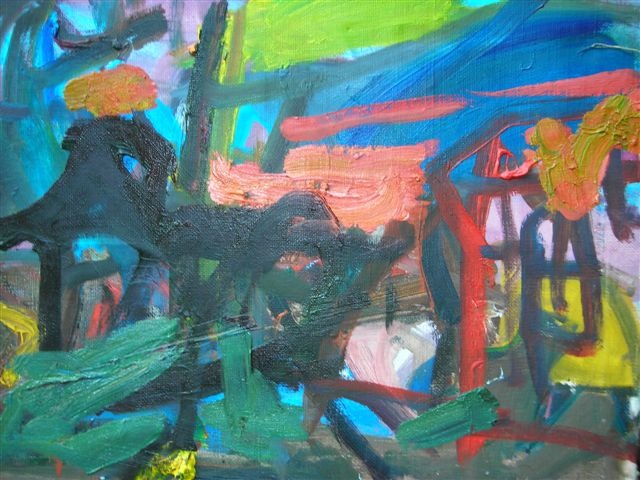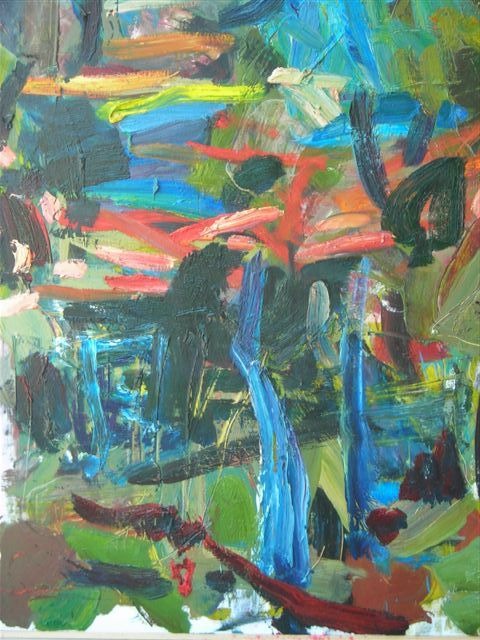IN MEMORIAM OF A.VAITKŪNAS: “SUNSETS” 0
(Arūnas Vaitkūnas (1956-2005). "Sunset", canvas, oil, 46x55cm; "Sunset 2", canvas, oil, 37x53cm; "Landscape (Sunset)", canvas, oil, 92x73cm. Autumn of 2004, Margionys) Aušra Barzdukaitė-Vaitkūnienė, July of 2007
www.kamane.lt, 2007 08 15
A.Vaitkūnas. Sunset. 2004
A.Vaitkūnas. Sunset 2. 2004
A.Vaitkūnas. Landscape (Sunset). 2004.
Afternoon of autumn of 2004. A lonely child is eating. The mood is like in a Japanese haiku.
Arūnas has given me a volume of Japanese haiku as a present. Earlier – a poetry book by G.Traklis.
He loved such poetry. The sensing of existence. Autumn evenings which are painful, making one feel worry and longing. Metaphysical longing.
Arūnas is painting sunsets in the garden. Autumn-like ones – from yellow of cadmium to pure orange. It is strange: the theme is expressive but the expression is tamed and even subdued in his paintings.
The motif is simple - a garden, silhouettes of tree branches and sunsets.
Arūnas has spoken about verticality as aiming for truth in art once. He has read many books by philosophers, especially contemporary ones, who are often cited in articles of Lithuanian art critics.
Horizontality in art could be the destruction of everything. Finding the essence and meaning is difficult. Hierarchy is necessary, and it is vital to turn back to the aiming for the Great Vertical, he spoke that autumn.
Arūnas wrote in his notebook back on November 13, 1988: “What does painting give to a human-being? Does it help one free out from inferior forces? Evidently, art is closely related with religion. Contemporary secular art – is it some compensation after religion has been separated from public life?”
The topic of sunset. Sunset for painting or post-modern art? I remember one evening when we spoke about painting: Arūnas said that, if painting had a beginning, it should end at some time.
However, I believe, that he cared about the colour and light first of all when painting sunsets.
A painter should be born as he brings a special look to the world. The look which others do not have.
Arūnas has said in childhood: “A painter has no holidays.”
It is true as he is always looking at light which turns into colour here on earth.
Three works, three sunsets. Very simple, of small format. They could serve as icons of nature for meditation. They could be hung in a village church as stations. The views are so familiar to field workers and village people – black crucified apple-trees in the background of autumn. The sky inviting to forget the damp earth covered with soggy leaves.
This autumn of 2004 painting became a continuation of himself to Arūnas. Only the movement of hand is important. The strokes are very organic as if prolonging his body. The painting is only implicit sometimes. The surface of a painting is like skin – scratched by the other end of a brush, beaten at places, while slow and soft strokes are felt in other spots as if they were touching a lover’s body.
The colour is turned into light. It surfaces from silhouettes of trees and branches of black, brown, deep ultramarine or purple colours. These sunsets – painting and the painter – are like one body now.
The theme – is it chosen by a painter or does it draw the attention of the painter at a particular time? To the nostalgic autumn sky, the striving for verticality? Is the future known?
NB. The paintings “Sunset” have been named by me. Arūnas has not left the names.











